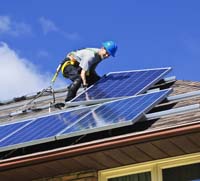Building or Buying Your Sustainable Home:
Resources for Buying or Renovating Your Green Home
by Rolf Priesnitz
 While most of my previous columns have focused on green building certification programs, such a home might not be within your budget or not practical for other reasons. So this time, I’m going to present some sources for information that will help you choose a greener home, or renovate your existing one so it’s more energy efficient and healthier. While most of my previous columns have focused on green building certification programs, such a home might not be within your budget or not practical for other reasons. So this time, I’m going to present some sources for information that will help you choose a greener home, or renovate your existing one so it’s more energy efficient and healthier.
Zero Net Energy Help
One of those sources that’s caught my eye recently is CARB (Consortium for Advanced Residential Buildings). It is a group of building industry professionals, led by building systems consultancy Steven Winter Associates, Inc. (SWA), as one of six Building America teams that are working to achieve the U.S. Department of Energy’s goal of making zero net energy homes.
CARB helps design, engineer, construct, and test energy-efficient homes, several thousand of which have been built in communities throughout the U.S. Results range from a thirty percent improvement in energy efficiency with little or no cost to the builder, to truly “zero-net-electric” homes that consume virtually no electrical energy.
In addition to its target audience of builders, CARB provides a great deal of information for interested owner-builders and homeowners looking to retrofit. Its website www.carb-swa.com provides how-to information and resource guides for various aspects of energy-efficient building, as well as a variety of project case studies, involving both high-end houses and affordable ones (including a couple built for Habitat for Humanity). The group also publishes an informative email newsletter.
Healthy Homes Help
I was pleased to see that the health of occupants is not overlooked by CARB. For instance, their website includes a guide to mold prevention, detection, and remediation entitled Mold: Ignorance Is Not Bliss. As we have written in past issues of Natural Life Magazine, as we build tighter, more efficient homes, moisture problems increase. And this guide, which includes a real life case study, will be helpful to any homeowner who suspects they have a mold problem.
Mold is just a part of indoor air quality – an issue that is not, in my opinion, given enough attention in the various green construction certification programs. I recently discovered the Health House® program of the American Lung Association of the Upper Midwest. The program is being restructured, and is only applicable to homes in the U.S. Upper Midwest, but the website offers excellent tip sheets for consumers and builders about how to make a home healthier, and maintain it that way. Topics include “sneezeless landscaping,” eliminating common asthma triggers, furnace filters, mold, radon, backdrafting, carbon monoxide, cockroaches, humidifiers and dehumidifiers, dust mites, lead, secondhand smoke, and identifying indoor pollutants.
There is also a section called “Top 10 Questions to Ask Your Builder,” designed to help you find a conventional builder who is open to working with you to create a healthier house.
Another great resource (if I do say so myself!) is our new book Natural Life Magazine’s Green & Healthy Homes. The author is my wife and partner Wendy, who also edits Natural Life Magazine. She provides help on avoiding dangerous household chemicals and plastics, making your own cleaning supplies, planning a green renovation or renewable energy retrofit, conserving water, dealing with mold and radon, and much more.
Green Real Estate Help
If you’re in the market for a greener home but don’t know where to begin, a green real estate professional may be able to help. Not only could they have information about truly sustainable homes on the market in your chosen area, their knowledge of environmentally friendly aspects of a home will help you see a regular home through greener eyes. They may be able to point out advantages such as energy efficient windows, doors and appliances, home positioning for optimized natural lighting and heating or cooling, landscaping that could promote natural shading or reduced watering require- ments, and similar features. They should also be able to advise you about green tax incentives or credits available for upgrades or improvements that you might want to make to a home.
In Canada, the National Association of Green Agents and Brokers is a non-profit association of Greerealestate™ Real Estate representatives. It has close to 30,000 members across the country. In the U.S., the National Association of Realtors helps its members meet growing consumer demand for green building practices and energy efficient homes with a Green Designation for Realtors® (www.greenresourcecouncil.org).
And finally, here’s a resource for real estate professionals who want to green their multiple listing service: www.greenthemls.org.
Rolf Priesnitz is the founder and Publisher of Natural Life Magazine, and has over forty years of experience in the construction industry.
|

